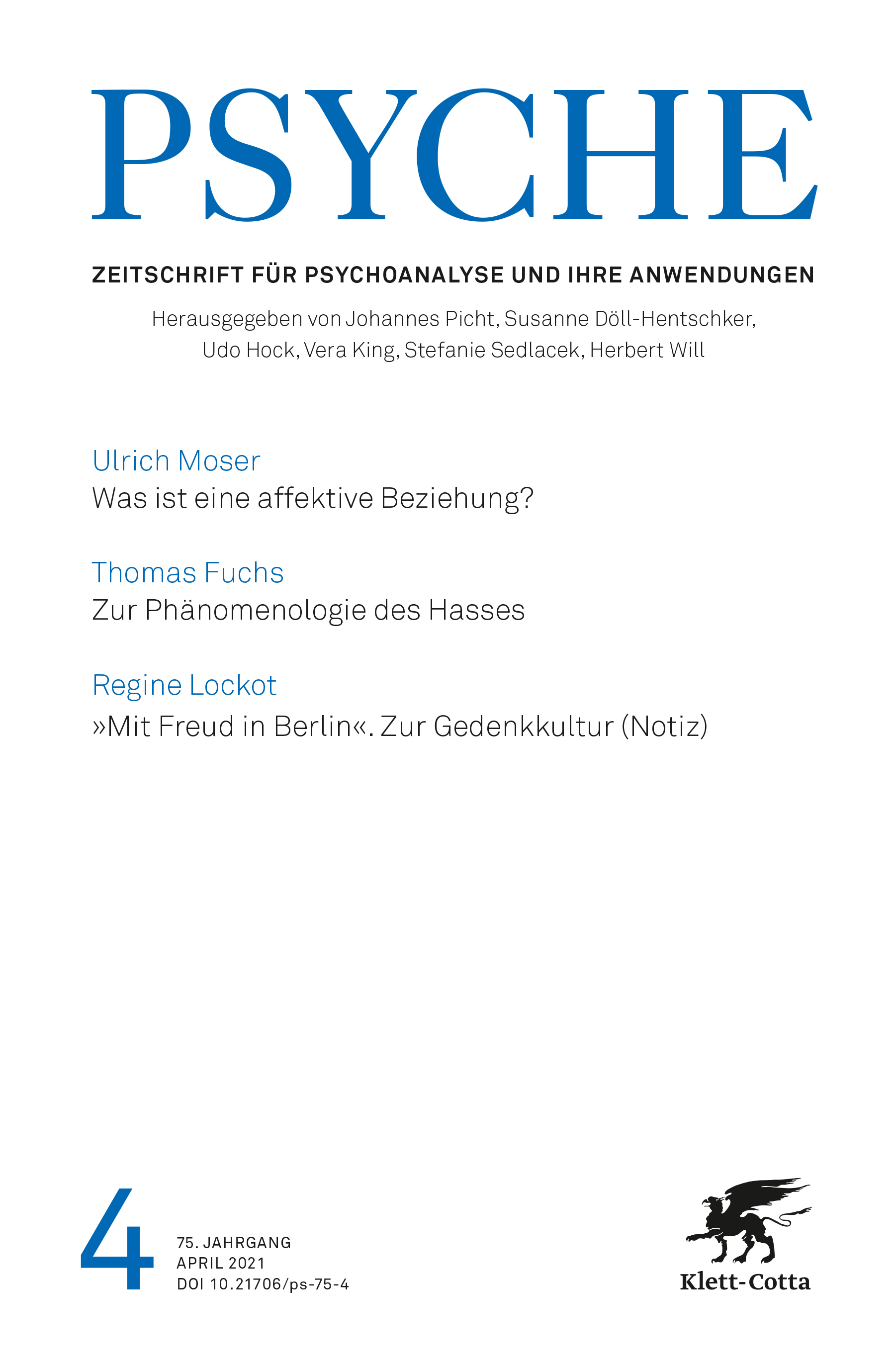PSYCHE, 2021, Jg. 75, Ausgabe 4
Print-Ausgabe
eJournal
Bibliographische Angaben
Details
Eine tragfähige affektive Beziehung wird als Grundlage für reflexive kooperative Prozesse in der psychoanalytisch orientierten Therapie erachtet. Was ist die Essenz dieser affektiven Bindung (des Attachments)? Es werden zwei bildhafte Konzepte entwickelt: das affektive Feld und die Trajektorie. Letztere ist als ein Weg der affektiven Information zwischen den Protagonisten gezeichnet. Jedes Selbst hat ein affektives Feld. Die Felder zwischen zwei Selbsten werden verknüpft, jedoch nicht im Sinne der Feldtheorie, die eine eigenständige Entwicklung eines gemeinsamen Feldes postuliert. In einem wissenschaftstheoretischen Exkurs werden die Ansätze »Feld« und »two singles« als gleichwertige Möglichkeiten diskutiert, Intersubjektivität zu verstehen. Die affektive Beziehung entwickelt sich zunächst zu den beiden Funktionen der resonanten und der responsiven Relation, um dann zunehmend durch die kognitive überlagert zu werden. Affektive Kommunikation ist nicht identisch mit der affektiven Bindung. Es werden Störungen im Bereich der Psychosen und Formen früher Störungen beschrieben. Die Ergebnisse der Bindungsforschung sind bekannt, spielen aber in dieser klinisch ausgerichteten Arbeit nur hintergründig eine Rolle.
A resilient affective relationship is considered to be the basis for reflexive cooperative processes in psychoanalytically oriented therapy. What is the essence of this affective attachment? The author expounds two metaphorical concepts: the »affective field« and the »trajectory«. The latter is a path for affective information between the protagonists of the relationship. Every self has an affective field. The fields between the two selves are linked, but not in the sense propagated by field theory, which postulates the independent development of a joint field. In an excursus of a science-theoretic nature, the author discusses »field« and »two singles« as equivalent approaches to understanding intersubjectivity. Initially, the affective relationship takes shape in terms of the two functions »resonance« and »responsiveness«. Subsequently, the affective element is increasingly overlayered by the cognitive aspect. Affective communication is not synonymous with affective attachment. The author describes disruptions associated with psychoses and early disorders. The findings produced by attachment research are well-known but play only a background role in this clinically oriented article.
Une relation affective viable est considérée dans la thérapie psychanalytique comme la base des processus coopératifs réflexifs. Quelle est l’essence de ce lien affectif (attachment) ? Deux concepts très parlants sont proposés : le champ affectif et la trajectoire. Cette dernière est présentée comme chemin d’informations affectives entre les protagonistes. Chaque moi a un champ affectif. Les champs entre deux moi sont liés, mais pas au sens de la théorie des champs, qui postule un développement indépendant d’un champ commun. Un rapprochement avec la théorie des sciences permet de discuter les approches « champ » et « two singles » comme moyens tout aussi valables de comprendre l’intersubjectivité. Au départ, la relation affective se développe dans les deux fonctions de la relation résonante et de la relation responsive. Puis, de plus en plus, la relation affective est superposée à la relation cognitive. La communication affective n’est pas identique à l’attachement affectif. Des troubles dans le domaine de la psychose et des troubles précoces sont décrits. Les résultats de la recherche sur l’attachement sont bien connus, mais ne jouent qu’un rôle secondaire dans ce travail clinique.
Hass wird in der Arbeit als eine anhaltende affektive Gesinnung verstanden, die auf eine erlebte Kränkung oder Ungerechtigkeit zurückgeht und auf Rache an ihrem Urheber, in extremen Fällen auf die Vernichtung des Feindes gerichtet ist. Die Dynamik und Radikalität insbesondere des malignen Hasses resultiert, so die These des Autors, aus einer Affektretention, die durch die selbst empfundene Schwäche oder Ohnmacht des Hassenden bedingt ist. Durch diesen Rückstau wird der Hass demnach in der Latenzphase immer weiter genährt, bis er schließlich in akute destruktive Handlungen umschlagen kann. Als charakteristische Struktur des Hasses wird dabei eine Dialektik von Selbststeigerung und Selbstdestruktivität mit fortschreitender Entleerung des Selbst herausgearbeitet. Diese individuelle Dynamik findet sich in oft potenzierter Form im Hass von Gruppen wieder. Der Autor untersucht die Phänomenologie des Hasses und die daraus resultierende Form von Destruktivität anhand literarischer Beispiele, psychischer Störungen und gesellschaftlicher Phänomene.
The author understands hate as a sustained affective attitude deriving from disparagement or injustice and directed at the author of that injustice, culminating in extreme cases in the destruction of the perpetrator. He contends that the dynamics and the radicalism especially of malignant hatred results from affect retention conditioned by the (subjective) weakness or impotence of the hater. Pent up in this way, hate is exacerbated in the latency phase and often manifests itself ultimately in acute destructive action. The author identifies the characteristic structure of hate as a dialectic between self-aggrandizement and self-destructiveness accompanied by increasing evacuation of the self. This individual dynamic is frequently encountered in a potentiated form in collective hatred. The author investigates the phenomenology of hate with reference to literary examples, psychic disorders, and societal phenomena.
Dans cet article, la haine est comprise comme une disposition affective durable consécutive à l’expérience d’un outrage ou d’une injustice et qui vise la vengeance contre son auteur, voire dans des cas extrêmes l’anéantissement de l’ennemi. La dynamique et la radicalité de la haine maligne en particulier résultent, selon la thèse de l’auteur, d’une rétention de l’affect causée par la faiblesse ou l’impuissance perçues comme telles par celui qui hait. Conséquence de cette rétention, la haine est ainsi nourrie de plus en plus dans la phase de latence jusqu’à ce qu’elle puisse finalement se transformer en actions destructrices aiguës. Une dialectique de l’augmentation du soi et de l’autodestruction aboutissant au vidage progressif du soi signe la structure caractéristique de la haine. Cette dynamique individuelle se retrouve souvent sous une forme accentuée dans les groupes. L’auteur étudie la phénoménologie de la haine et la forme de destruction qui en résulte à travers des exemples tirés de la littérature, des troubles psychologiques et des phénomènes sociaux.
Hefte der gleichen Zeitschrift
Alle Hefte der Zeitschrift


Bestell-Informationen
Service / Kontakt
Kontakt



